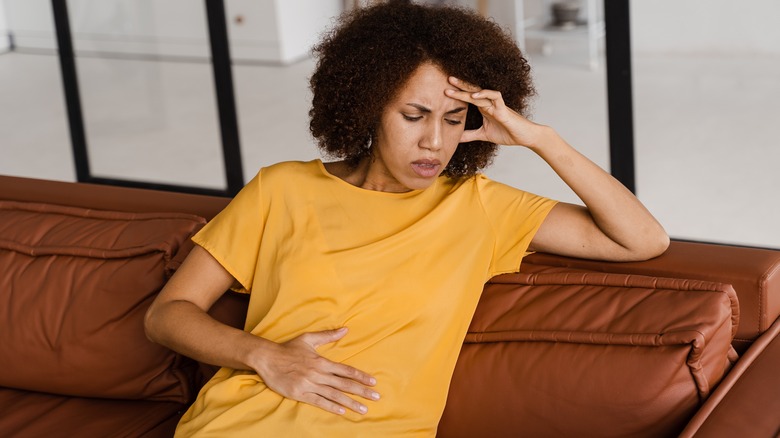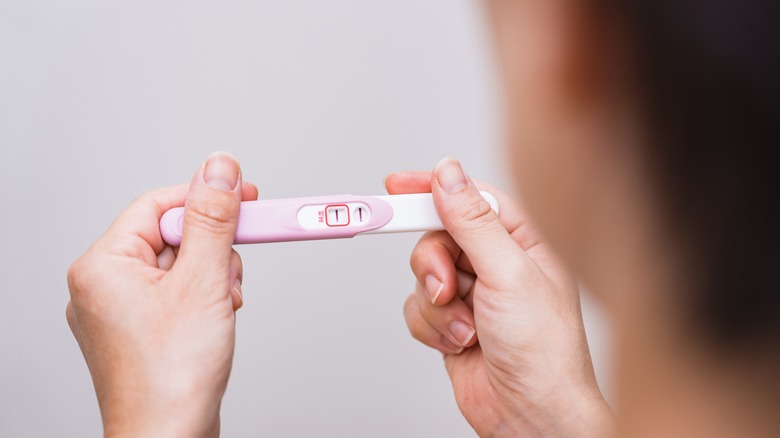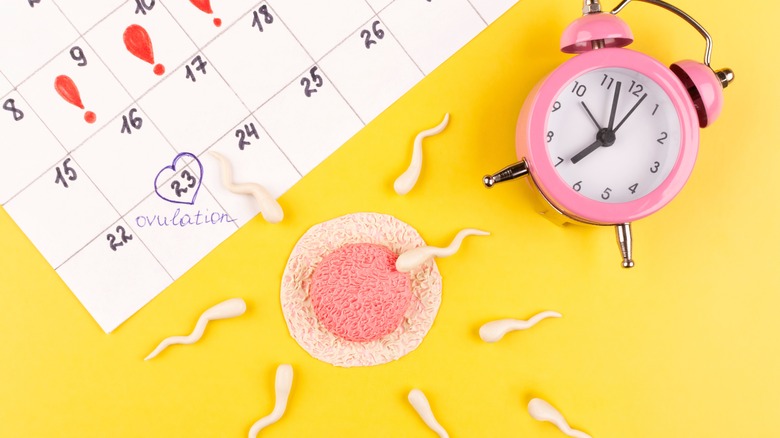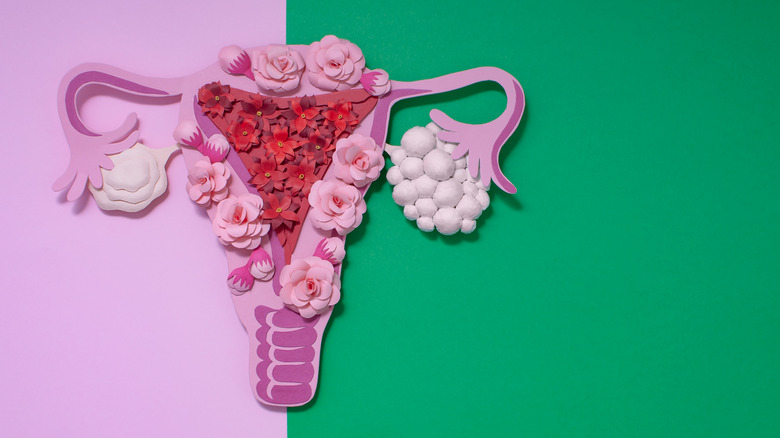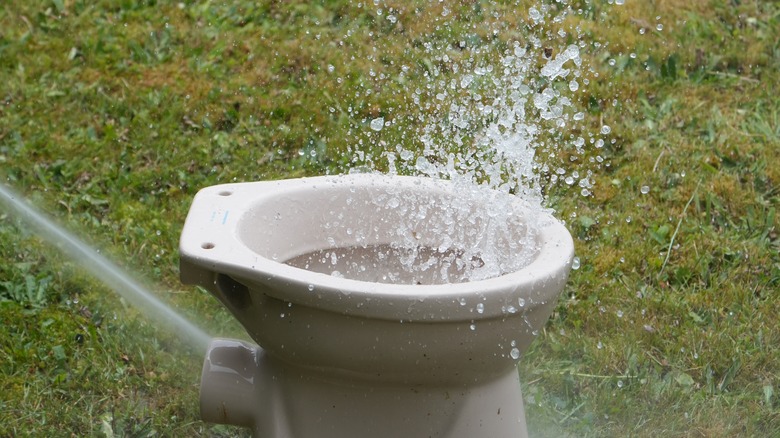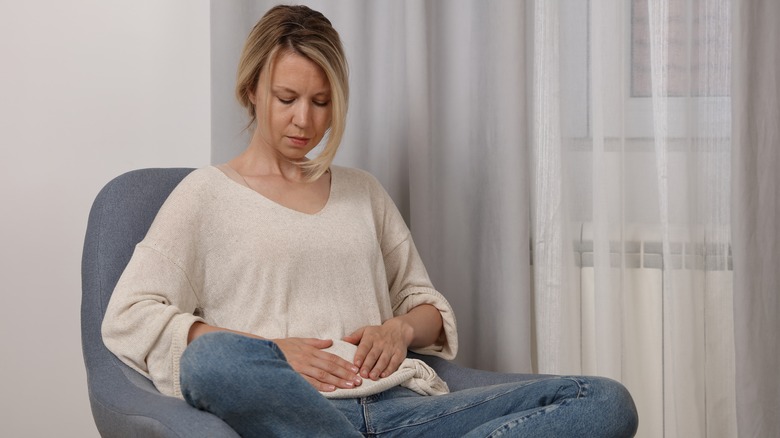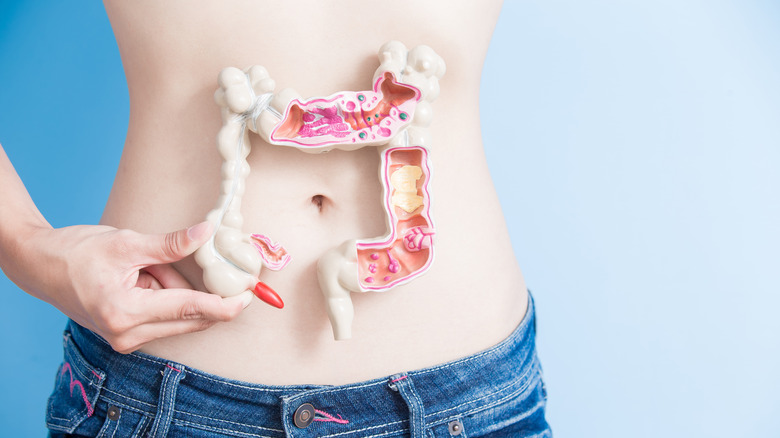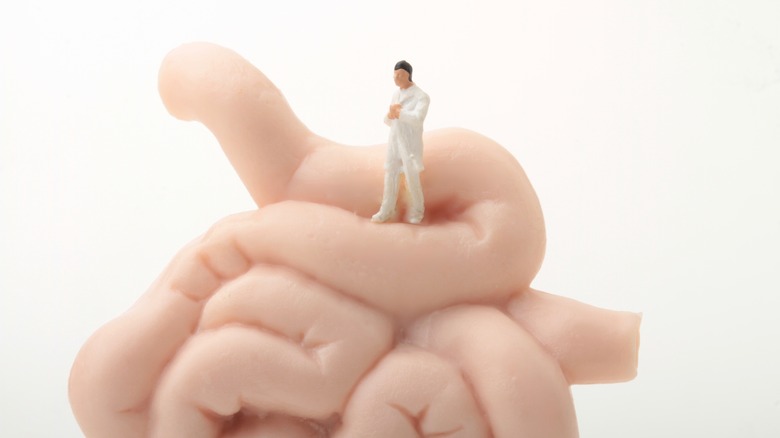What Does It Mean When You Have Cramps But No Period?
The feeling of abdominal or pelvic cramps can vary greatly from person to person and depending on the cause (per Buoy Health). It can be a mild generalized feeling of discomfort, or something as severe as a sharp, stabbing pain. The abdomen is the part of the body between your chest and pelvis. It houses your internal digestive organs which are the stomach, liver, gallbladder, pancreas, small intestine, and large intestine; and it is also where the kidneys and spleen can be found (via WebMD). Below the abdomen is your pelvis, where the reproductive organs are located, as well as your bladder, urethra (tube where urine flows out), and rectum (per Healthline).
Apart from organs, your abdomen and pelvis also contain muscles, connective tissues, blood vessels, and nerves that help support and maintain the body's functions (via WebMD). It is no surprise, then, that abnormality in any one of these structures can cause you to feel cramps. Depending on the cause, they may be felt in the area where the diseased part is located, in a localized area away from the anatomic location of the diseased structure (i.e., referred pain), or throughout the whole abdominal and/or pelvic area. According to Buoy Health, although menstrual cramps are one of the most common causes of belly cramps a woman may experience, you may feel cramps outside of your cycle, and the cause may not have anything to do period at all.
You may be pregnant
Pregnancy can lead to many changes in a woman's body; after all, it has to allocate space for another human being to grow inside it. Aside from not having your period, abdominal pain or cramps can also be a consequence of these changes, but they may also be a sign of something more serious. According to the American Pregnancy Association, common causes of cramps during pregnancy include stretching of the round ligament that attaches the uterus to your groin, trapped gas, constipation, and Braxton Hicks contractions (i.e., irregular spasms that are distinct from labor contractions). These can all cause discomfort but are generally benign and non-threatening to you and your baby.
More serious causes of cramps include miscarriage, ectopic pregnancy, placental abruption, and preeclampsia. Medical News Today states that miscarriage (loss of a baby before 20 weeks) is a common complications in early pregnancy, affecting an estimated 25% of pregnancies. The Cleveland Clinic says that an ectopic pregnancy can be detected via a first-trimester pregnancy scan, typically by week eight. Both complications may cause light or heavy bleeding in addition to abdominal cramps. For later pregnancies, placental abruption (separation of the placenta before the baby is born) and preeclampsia (high blood pressure with protein excretion in the urine) not only can cause a woman to experience cramps, but can also be life-threatening to both the mother and the baby (per the American Pregnancy Association).
You could be ovulating
If you are not pregnant and you have cramps regularly in between your menstrual cycles, your eggs may be the culprit. Mittelschmerz is the term used to describe the pain you feel during ovulation. It is German for "middle pain," which makes sense since ovulation occurs 14 days before the start of your period, and a typical cycle lasts around 28 days. According to the Mayo Clinic, mittelschmerz can last for as short as a few minutes or may linger for a couple of days. The pain can usually be felt on only one side of your lower abdomen and can vary in intensity. You may also notice spotting or vaginal discharge around this time. The location of the pain depends on which ovary is releasing the egg, so it is possible for you to feel alternating pain on your left and right sides from month to month, or have pain on the same side for consecutive cycles.
WebMD explains that not all women will have painful ovulation. Its cause is unclear, but it may be due to irritation of the abdominal cavity by fluid or blood that is released with the egg. The pain usually goes away without treatment, but it can be relieved using pain relievers like ibuprofen, which can be helpful in women who experience severe cramping. The only way to prevent mittelschmerz is through preventing ovulation, and this can be achieved by taking combined oral contraceptives.
You may have growths in your ovaries
Growths in the ovaries can be benign or harmful. According to the Cleveland Clinic, ovarian cysts are fluid-filled sacs that can grow on one or both of your ovaries. There are many different types, the most common of which are functional cysts, which form as a normal response to the hormonal and structural changes that occur during the menstrual cycle. Other types of ovarian cysts that are not normal reactions to your period include cystadenomas (found on the surface of the ovary), teratomas (made up of all types of tissue including skin, hair, and teeth), endometriomas (made up of the same tissue as the inner lining of the uterus), and ovarian tumors (made up of cancerous cells).
Healthline states that it is possible for a woman to have ovarian cysts and not have any symptoms, but symptoms may arise as the cyst grows, compresses nearby structures, twists around its attachments (i.e., torsion), or ruptures. In addition to lower abdominal pain, women may experience bloating, pain during bowel movements or sex, tender breasts, nausea, vomiting, and fever.
The National Institute of Child Health and Human Development notes that women with polycystic ovarian syndrome (PCOS) may or may not have growths in their ovaries (contrary to its name). The condition is caused by hormone imbalance that can present as abnormal hair growth, acne, thinning of scalp hair, and irregular cycles (via University Health News).
Endometriosis may be to blame
The inner lining of the uterus is called the endometrium, which proliferates and sheds every time you have your period (per Johns Hopkins Medicine). In about 10% of women aged 15 to 44, endometrial tissue forms outside of the uterus in such locations as the uterine ligaments, pelvic cavity, ovaries, the surface of the uterus, or the cavity between the uterus and the rectum. This condition is called endometriosis. Unlike in the uterus where the endometrial lining regularly sloughs off, endometrial tissue that forms elsewhere does not get removed from the body. Instead, it gets stimulated during the menstrual cycle and causes inflammation that can potentially lead to scarring, fibrosis, and formation of painful cysts.
According to the Office on Women's Health, the scarring that occurs in endometriosis can affect a woman's fertility and cause pelvic pain. Women may also experience other types of pain like severe menstrual cramps that can worsen over time, long-term pain in the lower back, deep pain during or after sex, painful bowel and bladder movements, and intestinal pain. Although it is more often seen in women who are in their 30s or 40s, your risk may also be increased if you have never had children, have long menstrual periods, have short cycles of less than 28 days, have a closely related family member with endometriosis, or have a health condition that prevents normal blood flow during your period (causing reverse menstruation).
You may have pelvic inflammatory disease
Pelvic inflammatory disease (PID) occurs when your upper reproductive organs (i.e., uterus, fallopian tubes, and ovaries) become infected. It is most often caused by untreated sexually transmitted diseases (STDs) of the vagina and cervix like chlamydia and gonorrhea, but it can also be caused by non-STD infections such as bacterial vaginosis. According to the Centers for Disease Control and Prevention (CDC), women who have multiple sex partners, have sex partners who have other partners, have a personal history of PID, are sexually active, became sexually active before 25 years old, use a douche (which may push bacteria upward), and have an intrauterine device (IUD) are more likely to get PID compared to the general population. Aside from lower abdominal pain that can be felt as cramps, women may also have fever, abnormal vaginal discharge, pain or bleeding during sex, burning pain when you pee, and bleeding when not on one's period. If left untreated, complications like scarring, ectopic pregnancy, infertility, and chronic pelvic pain can occur.
The American College of Obstetricians and Gynecologists (ACOG) states that more than 1 million women in America get diagnosed with PID every year. It is therefore advised for women to practice safe sex to avoid getting an STD that can lead to PID. You can follow this by using condoms every time you have sex (even if you have other forms of birth control), having monogamous sex with someone who has tested negative for STIs, and limiting your total number of sex partners.
Your pelvic floor muscles may be weak or injured
The pelvic floor is made up of several muscles that support the organs in the pelvis (via WebMD). In women, these are the uterus, bladder, and colon. Openings to the urethra, vagina, and anus are present on the pelvic floor. The pelvic floor muscles help control your bowel and bladder movements, and also contribute to certain sexual activities. In some women, the pelvic floor can be weak or injured, resulting in pelvic floor dysfunction. Weakness or injury can be due to a number of factors, including genetics, advanced age, being overweight, obesity, pregnancy, childbirth (vaginal delivery), prior pelvic surgery, neurological conditions (e.g., Parkinson's disease), and abnormal bowel or bladder habits like peeing too often or pushing too hard when you poop.
According to the National Center for Biotechnology Information (NCBI), pelvic floor dysfunction can be seen in up to 50% of women of childbearing age. It is caused by decreased activity, increased activity, or impaired coordination of the pelvic floor muscles, and is distinct from (but related to) pelvic organ prolapse (POP), which occurs due to lengthening of the pelvic muscles and subsequent extrusion of organs from the pelvis. When you have pelvic floor dysfunction, you may experience symptoms like difficulty peeing, incontinence, constipation, painful urination, lower back pain, and pelvic pain (per the Cleveland Clinic).
You might have painful bladder syndrome
Bladder pain syndrome, aka interstitial cystitis (IC), is defined by the National Institute of Diabetes and Digestive and Kidney Diseases (NIDDK) as a long-term condition that causes pain and other symptoms related to the urinary tract. Its cause is unknown, but it is more common in women compared to men (close to a ratio of 2:1), and is associated with other health conditions including irritable bowel syndrome, fibromyalgia, chronic fatigue syndrome, allergies, autoimmune diseases, and vulvodynia (chronic vulvar pain). It can be seen at any age, but is most common among adults; and a history of sexual abuse or physical trauma may also play a role in its development in women.
Symptoms of painful bladder syndrome may vary and depend on your age and how long you have had the disease (via Office on Women's Health). You can also experience flares, where symptoms suddenly become worse for a period of time and then spontaneously get better. IC symptoms include lower abdominal pain or discomfort (may get worse as your bladder gets full and go away after you pee), feeling the need to urinate right away, urinating an excessive number of times throughout the day, pelvic pain or pressure (including the groin and rectum), lower back pain, painful sex, discomfort that worsens during your period, and bladder sores and bleeding.
It could be a urinary tract infection
The urinary tract consists of parts of the urinary system, which are the kidneys, ureters, bladder, and urethra. Urinary tract infections (UTIs) begin in the lower tract (i.e., bladder and urethra) but they may also spread upward and infect the upper tract (i.e., ureters and kidneys). Infection can cause the organs to become irritated, a condition called cystitis in the bladder or nephritis in the kidneys. Some people with UTIs don't experience any symptoms while others do. Common symptoms of UTI include pelvic pain, persistent urge to urinate, burning pain when you pee, urinating frequently with small amounts of urine, cloudy urine, bloody urine (may look red, pink, or light brown), and strong-smelling urine. You may also experience back or side pain, fever, chills, nausea, and vomiting if you have a kidney infection (per Mayo Clinic).
The OWH states that UTIs are very common in women. It is so common that in fact, more than half of women will have at least one UTI in their life, and as many as 4 out of 10 of those women will get it again within six months. Additionally, women are 30 times more likely to get a UTI compared to men. This is because the urethra of women is shorter, making it easier for pathogens to spread upwards and infect the bladder. The urethra is also located close to the anus, which is where Escherichia coli, the most common bacteria that causes UTI, comes from.
You may have inflammatory bowel disease
As its name suggests, inflammatory bowel disease (IBD) is a group of disorders that cause inflammation of the bowels, along with other parts of the digestive tract. The most common ones are ulcerative colitis (UC) and Crohn's disease (CD). WebMD explains that IBD is an autoimmune disease, which means that it is caused by your immune system attacking your body. If you have UC, you may feel cramps on the lower side of your stomach. If you have CD, you may feel them in the right middle or lower side of your abdomen. Other symptoms include bowel movement problems, blood in your stool, weight loss, fever, and fatigue.
According to Healthline, people with CD may also have sores in their mouths, as well as ulcers and fissures around their genitals and anus. Because there is a problem with the immune system, symptoms outside of the digestive tract can also be seen such as inflammation of the eyes, skin problems, and arthritis.
IBD has increased rapidly in the U.S. since the 1990s, affecting close to 3 million American adults. Unfortunately, although IBD generally affects men and women equally, Komodo Health notes that women get diagnosed and treated for IBD at a much later time compared to men, despite having more emergency room visits and hospital admissions.
Appendicitis may be the cause
Appendicitis is inflammation of the appendix, which is a tube-shaped organ located on the lower right side of your belly (per Johns Hopkins Medicine). It can happen when the inside of the tube gets blocked by your own immune tissue, pathogens, stool, or tumors. When this happens, appendiceal secretions and the substance that is causing the obstruction can irritate the appendix and cause it to swell. Eventually, blood supply can get cut off and the appendix can burst, causing spilling of its contents inside your abdominal cavity. An infection called peritonitis can then happen, which is serious and can be life-threatening.
According to Medical News Today, the pain in appendicitis classically is first felt around the belly button, and eventually is felt the lower right side where the appendix is anatomically located. The pain may feel worse when you move, take a deep breath, cough, or sneeze; and it may be accompanied by other symptoms such as nausea, vomiting, appetite loss, constipation, diarrhea, trapped gas, fever, chills, and bloating. It is important to note, however, that only half of people with appendicitis will experience these symptoms, and others with the disease may have only minimal to absent symptoms.
The Mayo Clinic adds that appendicitis is commonly seen in children and adults between 10 to 30 years old. It is a medical emergency, and surgery is typically needed to remove the diseased appendix. Antibiotics may also be given if an infection is suspected.
It could be irritable bowel syndrome
Irritable bowel syndrome (IBS) is defined by the constellation of digestive symptoms that are not explained by injury or notable changes in your digestive tract (via the NIDDK). It is considered a functional disorder, which means that the symptoms of IBS are due to miscommunication between your brain and gut. This causes the muscles in your bowels to become more sensitive, which makes them contract inappropriately.
In the U.S., women are about twice as likely to have IBS compared to men. Some people predominantly experience diarrhea, others mostly have constipation, and there are also people who experience both symptoms with equal frequency. Other symptoms include lower belly pain or cramps, bloating, and swelling. The symptoms may get triggered by eating certain types of food (e.g., dairy, wheat, fruits) or taking certain medications (e.g., antibiotics, antidepressants). The location of the pain as well as the pattern of your bowel movements may also change over time (per the NCBI).
WebMD adds that women may experience more symptoms during their period, and some people may also have urinary tract and sexual problems. IBS is more common in people who are in their teens to their 40s, have family members with IBS, are under stress, have a mental health disorder, have a history of trauma, and who've experienced gut problems like food poisoning, traveler's diarrhea, and stomach flu.
You could be allergic or sensitive to certain types of food
Food allergies and intolerance may cause you to have stomach cramps. Similar to other forms of allergies, food allergy occurs when your body's immune system perceives a certain food as harmful. It then responds by releasing specialized cells and substances that work together to try and get rid of what you ingested. According to the Office on Women's Health, around 4% of adults and 8% of children have an allergy to certain types of food; the most common ones include shellfish, peanuts, tree nuts, fish, milk, and eggs. Aside from cramps, you may also experience a stuffy nose, watery eyes, sneezing, swelling on your face and mouth (or elsewhere), vomiting, diarrhea, and skin rash after ingesting food you are allergic to. An allergic reaction can be mild or life-threatening, so if you have a food allergy, it is important that you pay extra attention to what goes in the food that you eat.
On the other hand, Medical News Today explains that food intolerance occurs when your gut has a hard time digesting certain types of food. Examples include lactose (present in milk), fructose (present in fruits), gluten (present in wheat, barley, and rye), and salicylate (present in food, preservatives, and medicine). When you have food intolerance, you may experience bloating, excess gas, diarrhea, headaches, runny nose, fatigue, and stomach pain every time you ingest the food you are sensitive to.
It may be indigestion or food poisoning
Indigestion is an uncomfortable or stuffed feeling in the upper part of your belly, possibly coupled with heartburn and/or nausea (per Healthline). This often occurs after eating large meals or eating too fast, and may be caused by lifestyle factors (e.g., smoking, drinking, stress), medicines (e.g., aspirin, ibuprofen, antibiotics), and other health conditions (e.g., acid reflux, stomach cancer, peptic ulcers, food intolerance, IBS). Indigestion is usually benign, but it can cause serious symptoms and complications — including vomiting blood, unintentional weight loss, bloody stools, difficulty swallowing — that may make it hard for you to eat and/or drink.
Alternately, even if you eat the right type of foods and try to stay as healthy as possible, sometimes pesky germs can just find their way into your food and make you sick. According to the CDC, food poisoning can have mild to severe symptoms, and may occur hours or days after you ingest contaminated food. Common symptoms include cramps, nausea, vomiting, diarrhea, and fever. If you get hit with food poisoning, the most important thing you need to watch out for is dehydration. Make sure to drink plenty of fluids, even when it seems like they just want to come out of your body from either (or both) ends.
When should you seek help
You should always be mindful of when your cramps occur, how often they occur, where you feel it, what causes them to worsen or get better, and any other symptoms you may have. If you are sexually active and you have regular periods that have suddenly stopped, it may be a good idea to take a pregnancy test. Buoy Health says that you can relieve symptoms and treat mild cases of cramps at home by taking medicines like pain relievers, antidiarrheals, antacids, and stool softeners (depending on your symptoms); drinking lots of fluids to avoid dehydration; keeping a food diary to identify triggers and changing your diet accordingly; and using a heat pack or gently massaging your belly.
However, you should seek urgent care if you are experiencing sudden and severe cramps, abnormal vaginal bleeding, chest or neck pain, persistent vomiting, high fever, bloody stools or vomit (may appear red or black), difficulty breathing, yellowing of your skin or eyes, weight loss, abnormal heartbeat, and loss of consciousness (via MedicineNet). You should also seek care as soon as possible if you develop symptoms following trauma to your abdomen.
Cramps can be caused by abnormalities in your digestive, reproductive, or urinary systems, which means that they are not always related to your period. If your symptoms become bothersome and interfere with your daily activities, it is best that you speak with your doctor so that they can help you determine the cause and treat it accordingly.

